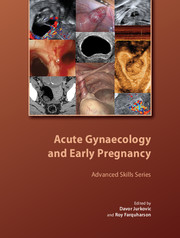Book contents
- Frontmatter
- Contents
- About the authors
- Acknowledgements
- Abbreviations
- Preface
- 1 Organisation and delivery of emergency care in early pregnancy and acute gynaecology
- 2 Epidemiology and aetiology of miscarriage and ectopic pregnancy
- 3 Diagnosis of miscarriage
- 4 Conservative and surgical management of miscarriage
- 5 Management of hyperemesis gravidarum
- 6 Diagnosis and treatment of recurrent miscarriage
- 7 Differential diagnosis and management of molar pregnancy
- 8 Drugs in early pregnancy
- 9 Diagnosis of tubal ectopic pregnancy
- 10 Conservative management of tubal ectopic pregnancy
- 11 Surgical management of tubal ectopic pregnancy
- 12 Diagnosis and management of non-tubal ectopic pregnancy
- 13 Diagnosis and management of acute pelvic pain
- 14 Management of vaginal bleeding in the acute clinical setting
- 15 Current concepts in screening and outpatient management of pelvic inflammatory disease
- 16 Diagnosis and management of haemorrhagic and septic shock
- 17 Role of minimally invasive surgery in acute gynaecology
- Index
Preface
Published online by Cambridge University Press: 05 July 2014
- Frontmatter
- Contents
- About the authors
- Acknowledgements
- Abbreviations
- Preface
- 1 Organisation and delivery of emergency care in early pregnancy and acute gynaecology
- 2 Epidemiology and aetiology of miscarriage and ectopic pregnancy
- 3 Diagnosis of miscarriage
- 4 Conservative and surgical management of miscarriage
- 5 Management of hyperemesis gravidarum
- 6 Diagnosis and treatment of recurrent miscarriage
- 7 Differential diagnosis and management of molar pregnancy
- 8 Drugs in early pregnancy
- 9 Diagnosis of tubal ectopic pregnancy
- 10 Conservative management of tubal ectopic pregnancy
- 11 Surgical management of tubal ectopic pregnancy
- 12 Diagnosis and management of non-tubal ectopic pregnancy
- 13 Diagnosis and management of acute pelvic pain
- 14 Management of vaginal bleeding in the acute clinical setting
- 15 Current concepts in screening and outpatient management of pelvic inflammatory disease
- 16 Diagnosis and management of haemorrhagic and septic shock
- 17 Role of minimally invasive surgery in acute gynaecology
- Index
Summary
Acute gynaecological problems are among the most common reasons for women of reproductive age to seek medical help. Early pregnancy complications account for the majority of gynaecological emergencies. In the UK, emergency gynaecological care used to be provided mainly by junior doctors working in casualty departments. However, it became clear that this model of care was not well suited to meeting the needs and increasing expectations of women. Developments in diagnostic ultrasound, which occurred in parallel, have led to wide acceptance of ultrasound as an essential tool for the assessment of developing pregnancy from a very early stage until delivery. Routine ultrasound scanning to assess fetal health and wellbeing has now been introduced in most developed countries.
To meet demands for more accessible, patient-centred care, early pregnancy assessment units were developed in the UK. This model of care has proved to be very successful and has been adopted by most acute hospitals. Early pregnancy units usually provide an integrated ultrasound scanning service to facilitate diagnostic work-up and to formulate appropriate management plans. Easier access to health professionals with an interest in early pregnancy care and greater availability of ultrasound scanning have resulted in increased attendance at early pregnancy units, with many women wishing to confirm that their pregnancy is normal rather than seeking help for serious medical complications. Improved diagnosis of miscarriage and ectopic pregnancy has prompted the development and implementation of more conservative management strategies.
- Type
- Chapter
- Information
- Acute Gynaecology and Early Pregnancy , pp. xiii - xivPublisher: Cambridge University PressPrint publication year: 2011

